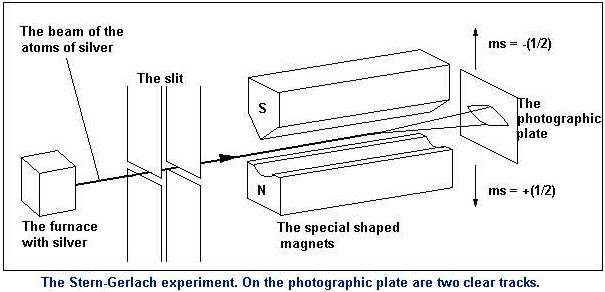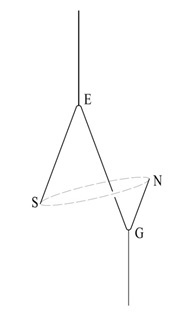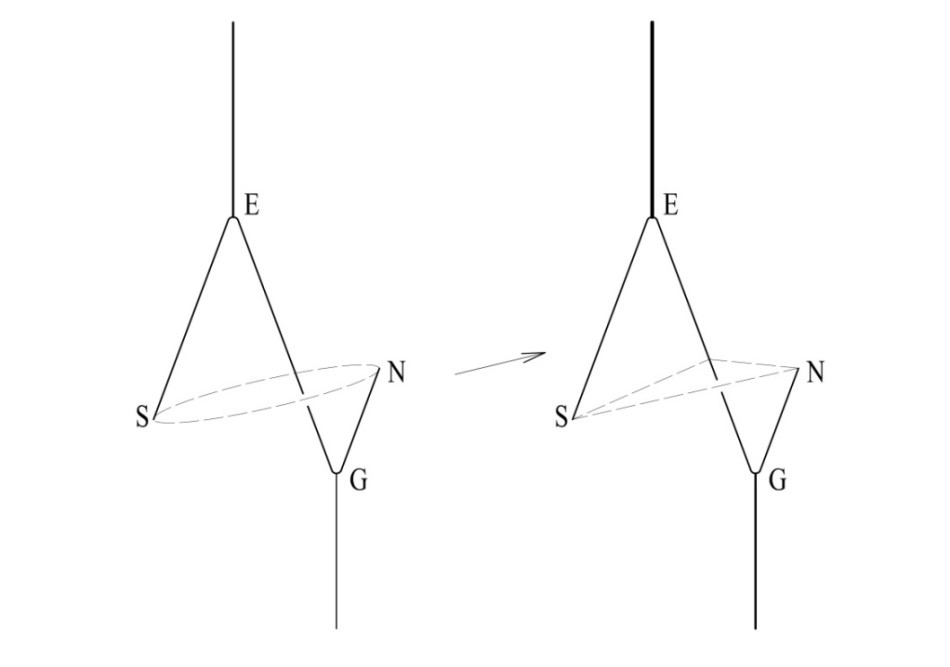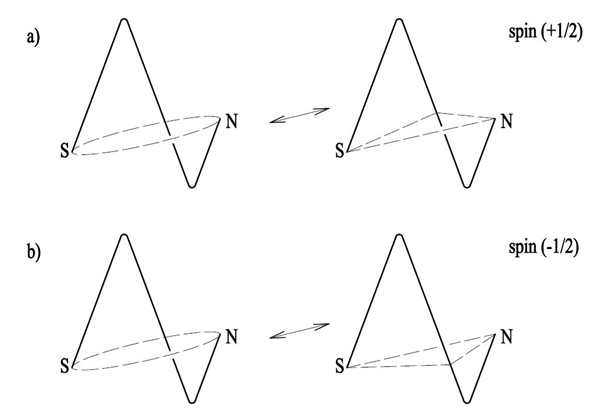In the early 1920s, Stern and Gerlach made an experiment with the aim to measure the magnetic dipole moment of silver atoms.

Figure 1
To achieve this, they passed a beam of electrically neutral atoms of silver through a strong non-uniform magnetic field perpendicular to the direction of the beam. The beam was neutral so the deflection should have occurred only as a result of the existence of a magnetic moment. Stern and Gerlach observed the beam split into two bands, one deflected upward, and the other downward. The center corresponding with a lack of deflection remained empty. The experiment showed that the spatial orientation of silver atoms in a non-uniform magnetic field is quantized. In the light of the knowledge of that time, the result was completely incomprehensible. This had to be theoretically explained in some way.
In 1925, Goudsmit and Uhlenbeck made a suggestion that an electron had another quantum number. The number would be related to the angular momentum of the electron, resulting from its rotation around its axis. Such an own angular momentum was called a spin. Later it appeared that taking a spin literally for an angular momentum was completely unjustified. It would be a velocity many times greater than the speed of light. However, physicists did not give up the name of “spin” but they assumed that under this (false) name there was an immanent feature on an electron quantifying its spatial orientation in a magnetic field. This way they admitted that they had no idea about the nature of this feature of the electron. Why cannot they say anything about the nature of spin? Because they do not know the structure of the electron. The key to solve the mystery what a spin of an electron is lies in the knowledge on how the electron is constructed. Since Model 31 presents a concept of the construction of the electron, showing how the electron gains the spin feature becomes fully justified. It is worth noting that a reasonable presentation how a spin of an electron is formed will be a powerful evidence of the validity of Model 31 assumptions.
The essence of Model 31 is the assumption that in parallel with the world of atoms, there exists the world of energy quanta and the world of dark energy. Let us take into account a single quantum from the sea of energy quanta filling the universe. In a high-magnification it looks as shown in Figure 2.

Figure 2
This is a string in the form of a flat, two-dimensional little spring. Affected by particles of dark energy, this spring performs an oscillatory motion. The more it is stressed, the higher the frequency of its vibrations. This frequency may reach the values from 100 to 1020 and more Hertz. In addition to its oscillatory motion, the quantum performs a progressive, linear motion.
Vibrating ends and apexes of the little spring produce the lines of forces from dark energy. Vibrating with various frequencies two ends of the little spring (N and S) produce the lines of force of the magnetic field. Vibrating with various frequencies two apexes of the little spring (E and G) produce two lines of fields, distinct in terms of “force”, parallel to each other and perpendicular to the lines of the magnetic field. In the figure, the “force” of these lines is reflected in their thickness. In the next stage of evolution, the lines E will become the source of the electric field, and the lines G will be the lines of the gravitational field. In a quantum of energy, the vibrating ends N and S form a magnetic dipole; they are the source of the magnetic field lines.
As it is apparent from the above, a quantum of energy is a magnetic dipole. In the macroworld, this is an equivalent to a bar magnet. A quantum of energy is formed from magnetic monopoles; it is an elementary dipole; it cannot be divided.
Let’s assume that the stress of the quantum of energy presented above is still growing. At some point, the forces stabilizing this little spring (the elasticity forces of a string) will be too weak and the spring will get deformed (see Figure 3).

a quantum of energy an electron
Figure 3
Such a deformed quantum becomes an electron.
The transformation of a quantum of energy into an electron presented in figure 3 can occur in two ways (see Figure 4).

Figure 4
If it gets deformed in one direction, its magnetic field lines will arrange as shown in Figure 4a. If it gets deformed in the other direction, its magnetic field lines will arrange differently, as shown in Figure 4b. It is easy to notice that the electrons shown in Figures 4a and 4b are mirror images. This means that two identically formed electrons may have differently arranged in space magnetic field lines (they may be spacially quantized); that is they may arrange differently (in two ways) in the external magnetic field. As mentioned above, in the physics of elementary particles, such a phenomenon is known under a false name of a spin.
Model 31 in Figure 4:
– shows how an electron gains the spin feature,
– shows that in an extremely simple way a spin of an electron is associated with its construction,
– shows that a spin of an electron is not associated with its rotation around its axis, as it is considered by the modern physics.
A spin is a permanent feature of each electron but under certain conditions the value of the spin can change (+1/2 to -1/2 or inversely). A change of an electron spin in a given body causes a 1800 change of the direction of of the magnetic field lines generated by this body. This phenomenon plays the main role in creating rotational motion of stars and maintaining a constant temperature of stars [see the note THE ROTATIONAL MOTION OF STARS (THE MECHANISM OF THE PHENOMENON ON THE EXAMPLE OF THE SUN)].
The spin feature belongs only to an electron or positron.
As presented in the note SYMMETRY BETWEEN MATTER AND ANTIMATTER CONFIRMED. ANTIMATTER FOUND, the components of the nucleus, a proton and neutron, are made of electron-positron pairs. If these composite particles have a spin, then it comes from an electron or positron which are their components. A spin of an electron and positron is ½. Thus, a proton and neutron should have spins with a value of ½. This is indeed a fact. This is how we obtained another powerful evidence of the validity of Model 31.

